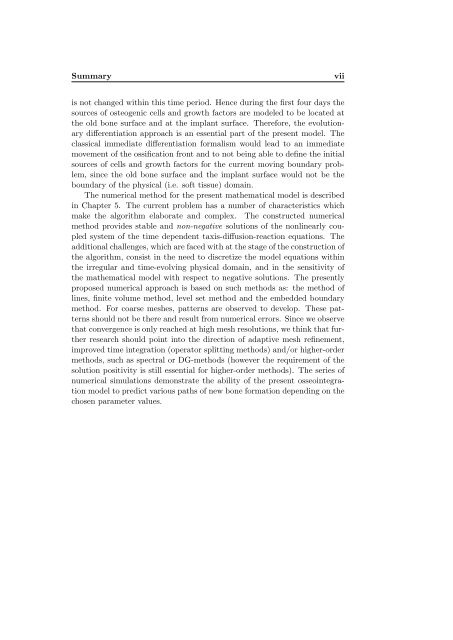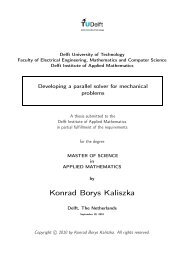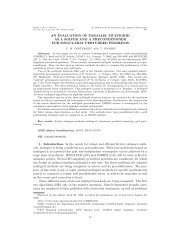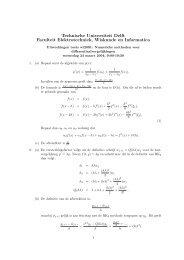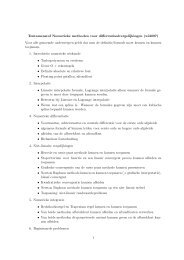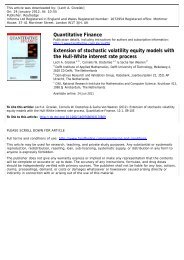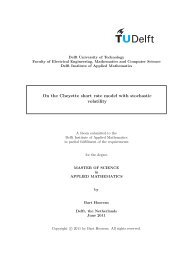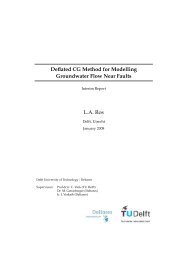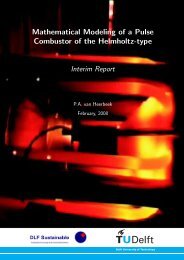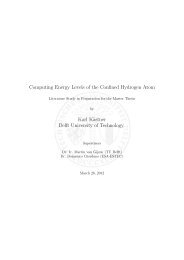- Page 1 and 2: Modeling bone regeneration around e
- Page 3: to my parents, Masha and Paulinka
- Page 9 and 10: SamenvattingModelleren van botregen
- Page 13 and 14: CONTENTSSummarySamenvattingvix1 Int
- Page 15: CONTENTSxv5.3.7 Treatment of the re
- Page 18 and 19: 2 Chapter 1. IntroductionNecrotic p
- Page 20 and 21: 4 Chapter 1. Introductionorganisms.
- Page 22 and 23: 6 Chapter 1. Introductionenhances f
- Page 24 and 25: 8 Chapter 1. IntroductionGómez-Ben
- Page 26 and 27: 10 Chapter 1. Introductionstability
- Page 28: 12 Chapter 1. Introductionand bioch
- Page 31 and 32: 2.2. Biological model 15this chapte
- Page 35 and 36: 2.3. Stability analysis 19The equat
- Page 37 and 38: 2.3. Stability analysis 21χ = α m
- Page 39 and 40: 2.3. Stability analysis 23Let us de
- Page 41 and 42: 2.3. Stability analysis 25Remark 2.
- Page 43 and 44: 2.3. Stability analysis 27where⎛
- Page 45 and 46: 2.3. Stability analysis 29Lemma 2.1
- Page 47 and 48: 2.3. Stability analysis 31Since k n
- Page 49 and 50: 2.3. Stability analysis 332.3.4 Cor
- Page 51 and 52: 2.3. Stability analysis 35The other
- Page 53 and 54: 2.3. Stability analysis 37polynomia
- Page 55 and 56: 2.3. Stability analysis 39This cond
- Page 57 and 58:
2.4. Numerical results 41or in the
- Page 59 and 60:
2.4. Numerical results 43but such t
- Page 61:
2.5. Conclusions 45ical simulations
- Page 64 and 65:
48 Chapter 3. Evolutionary cell dif
- Page 66 and 67:
50 Chapter 3. Evolutionary cell dif
- Page 68 and 69:
52 Chapter 3. Evolutionary cell dif
- Page 70 and 71:
54 Chapter 3. Evolutionary cell dif
- Page 72 and 73:
56 Chapter 3. Evolutionary cell dif
- Page 74 and 75:
58 Chapter 3. Evolutionary cell dif
- Page 76 and 77:
60 Chapter 3. Evolutionary cell dif
- Page 78 and 79:
62 Chapter 3. Evolutionary cell dif
- Page 80 and 81:
64 Chapter 3. Evolutionary cell dif
- Page 82 and 83:
66 Chapter 3. Evolutionary cell dif
- Page 84 and 85:
68 Chapter 3. Evolutionary cell dif
- Page 87 and 88:
3.4. Numerical simulations 71T= 6 d
- Page 89 and 90:
3.4. Numerical simulations 73T= 6 d
- Page 91 and 92:
3.5. Discussion and conclusions 75c
- Page 93 and 94:
3.5. Discussion and conclusions 77o
- Page 95 and 96:
CHAPTER 4Moving boundary model fore
- Page 97 and 98:
4.2. Recent mathematical models 81o
- Page 99 and 100:
4.3. Moving boundary model 834.3 Mo
- Page 101 and 102:
4.3. Moving boundary model 85Assume
- Page 103 and 104:
4.3. Moving boundary model 87concen
- Page 105 and 106:
4.3. Moving boundary model 89classi
- Page 107 and 108:
4.3. Moving boundary model 91zero).
- Page 109 and 110:
4.4. Model validation 93geometry of
- Page 111 and 112:
4.4. Model validation 95Table 4.1:
- Page 113 and 114:
4.4. Model validation 97Table 4.2:
- Page 115 and 116:
4.4. Model validation 99c m0.2c tot
- Page 117 and 118:
4.4. Model validation 101c m0.2c to
- Page 119 and 120:
4.4. Model validation 103c m0.2c to
- Page 121 and 122:
4.4. Model validation 105ub=0.15 da
- Page 123 and 124:
4.4. Model validation 107c m0.2c to
- Page 125 and 126:
4.4. Model validation 109t=42 days
- Page 127 and 128:
4.4. Model validation 111t=6 days0.
- Page 129 and 130:
4.4. Model validation 113the end of
- Page 131 and 132:
4.4. Model validation 115randomday
- Page 133 and 134:
4.4. Model validation 1174.4.3.2 Co
- Page 135 and 136:
4.4. Model validation 119L nz=10nz=
- Page 137 and 138:
4.4. Model validation 121log 10 err
- Page 139 and 140:
4.4. Model validation 123log 10 err
- Page 141 and 142:
4.5. Results and discussion 125Area
- Page 143 and 144:
4.5. Results and discussion 127t=15
- Page 145:
4.6. Conclusions 129bone formation
- Page 148 and 149:
132 Chapter 5. Numerical algorithmi
- Page 150 and 151:
134 Chapter 5. Numerical algorithmT
- Page 152 and 153:
136 Chapter 5. Numerical algorithm5
- Page 154 and 155:
138 Chapter 5. Numerical algorithmp
- Page 156 and 157:
140 Chapter 5. Numerical algorithmO
- Page 158 and 159:
142 Chapter 5. Numerical algorithmw
- Page 160 and 161:
144 Chapter 5. Numerical algorithmo
- Page 162 and 163:
146 Chapter 5. Numerical algorithmf
- Page 164 and 165:
148 Chapter 5. Numerical algorithm5
- Page 166 and 167:
150 Chapter 5. Numerical algorithmN
- Page 168 and 169:
152 Chapter 5. Numerical algorithmd
- Page 170 and 171:
154 Chapter 5. Numerical algorithmT
- Page 172 and 173:
156 Chapter 5. Numerical algorithmI
- Page 174 and 175:
158 Chapter 5. Numerical algorithmi
- Page 176 and 177:
160 Chapter 5. Numerical algorithmL
- Page 178 and 179:
162 Chapter 5. Numerical algorithmT
- Page 180 and 181:
164 Chapter 5. Numerical algorithm1
- Page 182 and 183:
166 Chapter 5. Numerical algorithmN
- Page 184 and 185:
168 Chapter 5. Numerical algorithmn
- Page 186 and 187:
170 Chapter 5. Numerical algorithmw
- Page 188 and 189:
172 Chapter 5. Numerical algorithmc
- Page 190 and 191:
174 Chapter 5. Numerical algorithm1
- Page 192 and 193:
176 Chapter 5. Numerical algorithmc
- Page 194 and 195:
178 Chapter 5. Numerical algorithmc
- Page 196 and 197:
180 Chapter 5. Numerical algorithma
- Page 198 and 199:
182 Chapter 5. Numerical algorithmT
- Page 200 and 201:
184 Chapter 5. Numerical algorithmT
- Page 202 and 203:
186 Chapter 6. Conclusions and outl
- Page 204 and 205:
188 Chapter 6. Conclusions and outl
- Page 206 and 207:
190 Appendix At=7 days0.5c m0.201.4
- Page 208 and 209:
192 Appendix Awhere ⃗n is the out
- Page 210 and 211:
194 Appendix BRemark B.1. Since the
- Page 212 and 213:
196 Appendix BCase 1b are valid.Cas
- Page 214 and 215:
198 AcknowledgmentTheda Olsder has
- Page 217 and 218:
BIBLIOGRAPHY[1] I. Abrahamsson, T.
- Page 219 and 220:
BIBLIOGRAPHY 203[20] P. Colella, D.
- Page 221 and 222:
BIBLIOGRAPHY 205[42] L. Geris, J. V
- Page 223 and 224:
BIBLIOGRAPHY 207[64] P. Mayer-Kucku
- Page 225:
BIBLIOGRAPHY 209[89] U. Simon, P. A


